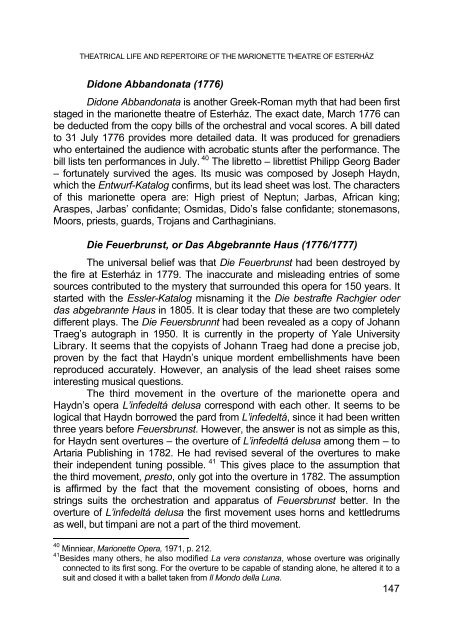musica - Studia
musica - Studia
musica - Studia
Create successful ePaper yourself
Turn your PDF publications into a flip-book with our unique Google optimized e-Paper software.
THEATRICAL LIFE AND REPERTOIRE OF THE MARIONETTE THEATRE OF ESTERHÁZ<br />
Didone Abbandonata (1776)<br />
Didone Abbandonata is another Greek-Roman myth that had been first<br />
staged in the marionette theatre of Esterház. The exact date, March 1776 can<br />
be deducted from the copy bills of the orchestral and vocal scores. A bill dated<br />
to 31 July 1776 provides more detailed data. It was produced for grenadiers<br />
who entertained the audience with acrobatic stunts after the performance. The<br />
bill lists ten performances in July. 40 The libretto – librettist Philipp Georg Bader<br />
– fortunately survived the ages. Its music was composed by Joseph Haydn,<br />
which the Entwurf-Katalog confirms, but its lead sheet was lost. The characters<br />
of this marionette opera are: High priest of Neptun; Jarbas, African king;<br />
Araspes, Jarbas’ confidante; Osmidas, Dido’s false confidante; stonemasons,<br />
Moors, priests, guards, Trojans and Carthaginians.<br />
Die Feuerbrunst, or Das Abgebrannte Haus (1776/1777)<br />
The universal belief was that Die Feuerbrunst had been destroyed by<br />
the fire at Esterház in 1779. The inaccurate and misleading entries of some<br />
sources contributed to the mystery that surrounded this opera for 150 years. It<br />
started with the Essler-Katalog misnaming it the Die bestrafte Rachgier oder<br />
das abgebrannte Haus in 1805. It is clear today that these are two completely<br />
different plays. The Die Feuersbrunnt had been revealed as a copy of Johann<br />
Traeg’s autograph in 1950. It is currently in the property of Yale University<br />
Library. It seems that the copyists of Johann Traeg had done a precise job,<br />
proven by the fact that Haydn’s unique mordent embellishments have been<br />
reproduced accurately. However, an analysis of the lead sheet raises some<br />
interesting <strong>musica</strong>l questions.<br />
The third movement in the overture of the marionette opera and<br />
Haydn’s opera L’infedeltá delusa correspond with each other. It seems to be<br />
logical that Haydn borrowed the pard from L’infedeltá, since it had been written<br />
three years before Feuersbrunst. However, the answer is not as simple as this,<br />
for Haydn sent overtures – the overture of L’infedeltá delusa among them – to<br />
Artaria Publishing in 1782. He had revised several of the overtures to make<br />
their independent tuning possible. 41 This gives place to the assumption that<br />
the third movement, presto, only got into the overture in 1782. The assumption<br />
is affirmed by the fact that the movement consisting of oboes, horns and<br />
strings suits the orchestration and apparatus of Feuersbrunst better. In the<br />
overture of L’infedeltá delusa the first movement uses horns and kettledrums<br />
as well, but timpani are not a part of the third movement.<br />
40 Minniear, Marionette Opera, 1971, p. 212.<br />
41 Besides many others, he also modified La vera constanza, whose overture was originally<br />
connected to its first song. For the overture to be capable of standing alone, he altered it to a<br />
suit and closed it with a ballet taken from Il Mondo della Luna.<br />
147

















